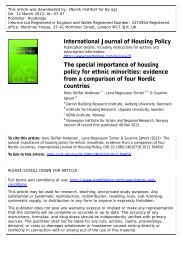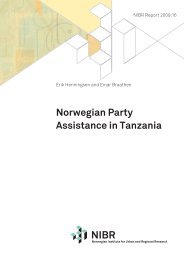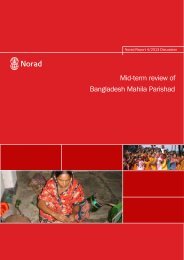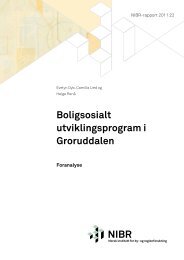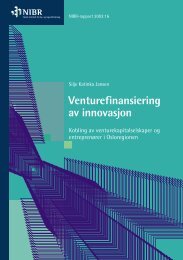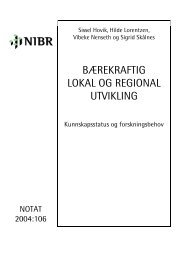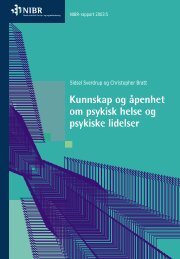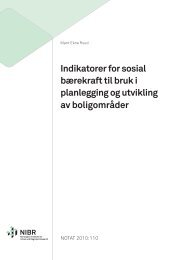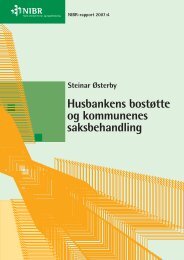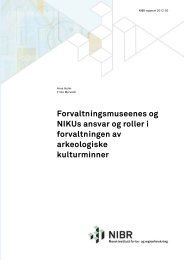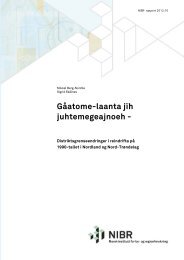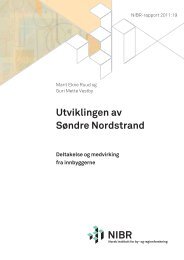Evaluation of the Southern and Eastern Africa Regional Centre for ...
Evaluation of the Southern and Eastern Africa Regional Centre for ...
Evaluation of the Southern and Eastern Africa Regional Centre for ...
- No tags were found...
Create successful ePaper yourself
Turn your PDF publications into a flip-book with our unique Google optimized e-Paper software.
20An important factor <strong>for</strong> impact also concerns <strong>the</strong> nature <strong>of</strong> networks <strong>and</strong>partnerships <strong>for</strong>med by <strong>the</strong> <strong>Centre</strong>. Some <strong>of</strong> <strong>the</strong>se issues will be followed up as <strong>the</strong>yemerge from <strong>the</strong> survey <strong>and</strong> <strong>the</strong> organisational level. Interviews were importanthowever, especially as previous evaluations had not interviewed <strong>the</strong> regional advisoryboard members. The networks <strong>for</strong> academic sustainability <strong>and</strong> quality wereconsulted. These included some <strong>of</strong> <strong>the</strong> 5 collaborating partners who ei<strong>the</strong>r haveMoUs or partnership roles <strong>and</strong> also members <strong>of</strong> <strong>the</strong>ir regional colloquia. In additionkey supporting institutions include Women’s Law at University <strong>of</strong> Oslo were alsointerviewed. Indeed <strong>the</strong> evaluators incorporated some visits as regional stop-overs inorder to seek better coverage <strong>of</strong> <strong>the</strong> <strong>Centre</strong>’s collaboration. But we also asked aboutnetworks <strong>for</strong> more policy <strong>and</strong> legal ends. For example, in <strong>the</strong> two country cases weattempted to speak with influential entities, such as <strong>the</strong> Law Commissions, <strong>and</strong> whereappropriate Parliamentary Committees (dealing with Women’s issues, <strong>for</strong> example)<strong>and</strong> also civil society actors to gauge <strong>the</strong> policy <strong>and</strong> legal ‘reach’ <strong>of</strong> <strong>Centre</strong> networks.Perceptions <strong>of</strong> <strong>the</strong> <strong>Centre</strong> in relation to <strong>the</strong> key actors or networks at national level(especially in Zimbabwe) but also regionally, in terms <strong>of</strong> regional women’s rights <strong>and</strong>legal st<strong>and</strong>ards were raised.5) Strengths <strong>and</strong> Weakness- Opportunities <strong>and</strong> Threats exercise: this was conducted in <strong>the</strong>participatory spirit <strong>of</strong> <strong>the</strong> Master course, with all relevant <strong>Centre</strong> staff. The objectivewas to prompt discussion as to <strong>the</strong> achievements <strong>and</strong> also any shortcomings etc. in<strong>the</strong> <strong>Centre</strong>’s approach according to <strong>the</strong> <strong>Centre</strong> itself. It is a valuable technique ingetting a lot <strong>of</strong> in<strong>for</strong>mation quickly, <strong>and</strong> in a manner which enables expression <strong>of</strong> <strong>the</strong>evaluated entity’s collective response <strong>and</strong> insights.6) Country case studies- <strong>the</strong> ToR asked <strong>for</strong> two countries to be visited. A number <strong>of</strong>countries send out students but only two were to be chosen. One had to beZimbabwe itself, as it is <strong>the</strong> location <strong>of</strong> <strong>the</strong> <strong>Centre</strong> <strong>and</strong> with <strong>the</strong> clear majority <strong>of</strong>graduates. The o<strong>the</strong>r was discussed with Norad <strong>and</strong> with <strong>the</strong> <strong>Centre</strong>. There were anumber <strong>of</strong> considerations taken into account. An important factor was whichcountry could show a degree <strong>of</strong> institutional impact. Though Zambia had beencovered in a previous evaluation, <strong>the</strong> evaluators considered that its selection <strong>for</strong> <strong>the</strong>present evaluation would demonstrate some continuity with <strong>the</strong> previous reviews.Fur<strong>the</strong>rmore, through <strong>the</strong> presence <strong>of</strong> a large number <strong>of</strong> Zambian police over <strong>the</strong>years on <strong>the</strong> course, <strong>the</strong>re is also real potential to show impact in a specific sector. Inaddition to <strong>the</strong>se two cases, because Nairobi was a brief stop-over to interview <strong>the</strong>regional advisory board chairwomen, <strong>the</strong> opportunity was taken also to speak withsome Kenyan graduates. Although not requested by <strong>the</strong> ToR, it did present awindow on a group <strong>of</strong> graduates not previously included in an evaluation. In anycase, <strong>the</strong> representativeness <strong>of</strong> <strong>the</strong> survey does, we believe, cover all sendingcountries.Some limitations include that <strong>the</strong> study was limited to two country case studies, albeitwith some limited findings added from a third. In general, responses <strong>of</strong> graduates areoverwhelmingly but not exclusively <strong>of</strong> female graduates (especially in Zimbabwe).Fur<strong>the</strong>rmore, because identifying graduate influence <strong>and</strong> impact was a key priority,perhaps <strong>the</strong> study did not address those students who have not had any impact <strong>and</strong>why this may be so. Though <strong>the</strong> <strong>Evaluation</strong> Team believes that <strong>the</strong> survey provides agood vehicle to mitigate <strong>the</strong>se issues, those students not demonstrating impact mightbe heavily reflected by <strong>the</strong> 52 per cent who did not respond. None<strong>the</strong>less, drawing



